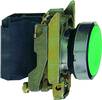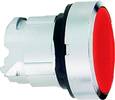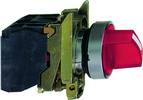

Pilot lights incorporating a protected LED are as visible as those with a conventional light source and provide a 10 year service life without any loss of brilliance.
Over the last few decades, pilot lights and illuminated control units have used two main types of conventional light source. In both cases, they suffer from a low light output and a limited service life.
In addition, their characteristics have not been ideal for use in an industrial environment (not mechanically robust, nor ideally suited for standard industrial lens colours).
The oldest type of light source is the incandescent lamp, and this is still the most commonly used. It works on the principle of heating a tungsten filament within a vacuum to white heat, thus producing light. However, despite their drawbacks, these lamps do have the advantages of being immune to electromagnetic interface, typically encountered in industry, and they radiate light in all directions. They are also low-cost and readily available. Their main disadvantage is that the filament, due to its high temperature, gradually vaporises and limits the service life of the lamp to between 500 and 5000 hours. Also, the fact that the filament is suspended in a vacuum means that there is little resistance to shock or vibration.
Another light source commonly used in industry is the fluorescent (neon) type. These units comprise a pair of electrodes mounted within a sealed capsule which is filled with gas. As current is passed between these electrodes, the resulting electron emissions excite the gas, which in turn produces photons (light).
To their credit, they are a low-cost and readily available device, they dissipate little heat and their service life is typically 50 000 h. Unfortunately their light output is weak and their range of colours is limited. Another disadvantage is that when used on DC their performance degrades rapidly and they can only function at higher voltages (greater than 65 V).

Protected LED technology lights the way forward
Today, industry recognises that the best way forward lies with the light emitting diode (LED). These devices comprise a semiconductor 'chip' encapsulated into a surface-mount (SMC) module which, in turn, is often housed in a conventional lamp base. Their operating principle relies on a semiconductor characteristic which creates direct photon (light) emissions when a current is passed through the LED 'chip'.
Despite its efficiency, the LED solution does have some constraints. These include a high sensitivity to electrostatic discharges, the requirement of a supply voltage between 1,7 and 3,6 V (depending on colour) and the fact that they are polarity conscious. Their operating temperature must remain between -25 and 85°C.
Fortunately these constraints can be overcome and are balanced by the real benefits of using LEDs and, despite the fact that service life will depend on factors such as operating current, colour and operating temperature, 100 000 hours of continuous operation (equivalent to 10 years) can easily be attained. Their low current consumption means that LEDs dissipate less heat than incandescent lamps and, in addition, they tend to be much smaller and their colours much stronger.
To enhance the quality of the Harmony range, Schneider Electric has selected an LED light source solution for pilot lights and illuminated control units. These LEDs feature SMT technology and are fitted with special control and protection circuits which negate the effects of electrostatic discharge, capacitive coupling and electromagnetic radiation.
In addition, these protective circuits inhibit illumination of the LED due to proximity switch or PLC I/O module leakage currents. Overvoltage protection is also incorporated to protect against the effects of lightning, inductive spikes generated by coil de-energisation and reverse polarity. Any interference, such as the energy resulting from coil de-energisation, is absorbed by the protection device and this prevents spurious illumination of the LED.

Three models of the pilot, for use on AC or DC, are available:
* Diameter 16 mm (6-30 V).
* Diameter 22 mm (24 V).
* Diameter 22 mm (110/220 V).
The diameter 22 mm models incorporate a full wave bridge to ensure usage on both AC and DC, and to remove the need to check polarity of connection.
For all illuminated units with integral LED, their design, including that of the lenses and diffusers, is such to provide maximum visibility from all directions (at least equivalent to incandescent lamps) and to surpass the performance of incandescent lamp units - while remaining in the same price range.
Schneider Electric
(011) 254 6400

© Technews Publishing (Pty) Ltd | All Rights Reserved